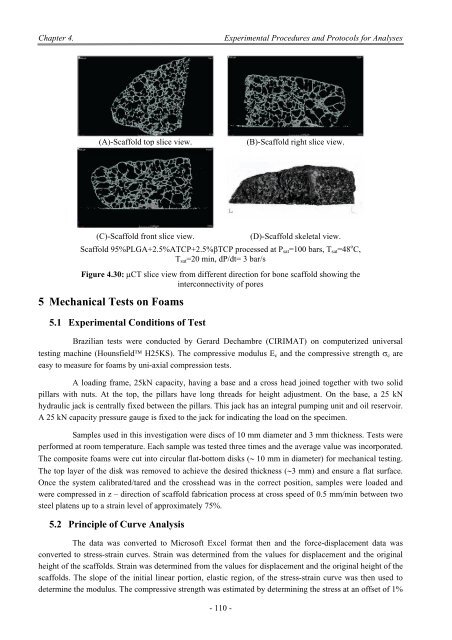Influence of the Processes Parameters on the Properties of The ...
Influence of the Processes Parameters on the Properties of The ...
Influence of the Processes Parameters on the Properties of The ...
Create successful ePaper yourself
Turn your PDF publications into a flip-book with our unique Google optimized e-Paper software.
Chapter 4.<br />
Experimental Procedures and Protocols for Analyses<br />
(A)-Scaffold top slice view.<br />
(B)-Scaffold right slice view.<br />
(C)-Scaffold fr<strong>on</strong>t slice view.<br />
- 110 -<br />
(D)-Scaffold skeletal view.<br />
Scaffold 95%PLGA+2.5%ATCP+2.5%TCP processed at P sat =100 bars, T sat =48 o C,<br />
T sat =20 min, dP/dt= 3 bar/s<br />
Figure 4.30: CT slice view from different directi<strong>on</strong> for b<strong>on</strong>e scaffold showing <str<strong>on</strong>g>the</str<strong>on</strong>g><br />
interc<strong>on</strong>nectivity <str<strong>on</strong>g>of</str<strong>on</strong>g> pores<br />
5 Mechanical Tests <strong>on</strong> Foams<br />
5.1 Experimental C<strong>on</strong>diti<strong>on</strong>s <str<strong>on</strong>g>of</str<strong>on</strong>g> Test<br />
Brazilian tests were c<strong>on</strong>ducted by Gerard Dechambre (CIRIMAT) <strong>on</strong> computerized universal<br />
testing machine (Hounsfield H25KS). <strong>The</strong> compressive modulus E c and <str<strong>on</strong>g>the</str<strong>on</strong>g> compressive strength c are<br />
easy to measure for foams by uni-axial compressi<strong>on</strong> tests.<br />
A loading frame, 25kN capacity, having a base and a cross head joined toge<str<strong>on</strong>g>the</str<strong>on</strong>g>r with two solid<br />
pillars with nuts. At <str<strong>on</strong>g>the</str<strong>on</strong>g> top, <str<strong>on</strong>g>the</str<strong>on</strong>g> pillars have l<strong>on</strong>g threads for height adjustment. On <str<strong>on</strong>g>the</str<strong>on</strong>g> base, a 25 kN<br />
hydraulic jack is centrally fixed between <str<strong>on</strong>g>the</str<strong>on</strong>g> pillars. This jack has an integral pumping unit and oil reservoir.<br />
A 25 kN capacity pressure gauge is fixed to <str<strong>on</strong>g>the</str<strong>on</strong>g> jack for indicating <str<strong>on</strong>g>the</str<strong>on</strong>g> load <strong>on</strong> <str<strong>on</strong>g>the</str<strong>on</strong>g> specimen.<br />
Samples used in this investigati<strong>on</strong> were discs <str<strong>on</strong>g>of</str<strong>on</strong>g> 10 mm diameter and 3 mm thickness. Tests were<br />
performed at room temperature. Each sample was tested three times and <str<strong>on</strong>g>the</str<strong>on</strong>g> average value was incorporated.<br />
<strong>The</strong> composite foams were cut into circular flat-bottom disks (10 mm in diameter) for mechanical testing.<br />
<strong>The</strong> top layer <str<strong>on</strong>g>of</str<strong>on</strong>g> <str<strong>on</strong>g>the</str<strong>on</strong>g> disk was removed to achieve <str<strong>on</strong>g>the</str<strong>on</strong>g> desired thickness (3 mm) and ensure a flat surface.<br />
Once <str<strong>on</strong>g>the</str<strong>on</strong>g> system calibrated/tared and <str<strong>on</strong>g>the</str<strong>on</strong>g> crosshead was in <str<strong>on</strong>g>the</str<strong>on</strong>g> correct positi<strong>on</strong>, samples were loaded and<br />
were compressed in z – directi<strong>on</strong> <str<strong>on</strong>g>of</str<strong>on</strong>g> scaffold fabricati<strong>on</strong> process at cross speed <str<strong>on</strong>g>of</str<strong>on</strong>g> 0.5 mm/min between two<br />
steel platens up to a strain level <str<strong>on</strong>g>of</str<strong>on</strong>g> approximately 75%.<br />
5.2 Principle <str<strong>on</strong>g>of</str<strong>on</strong>g> Curve Analysis<br />
<strong>The</strong> data was c<strong>on</strong>verted to Micros<str<strong>on</strong>g>of</str<strong>on</strong>g>t Excel format <str<strong>on</strong>g>the</str<strong>on</strong>g>n and <str<strong>on</strong>g>the</str<strong>on</strong>g> force-displacement data was<br />
c<strong>on</strong>verted to stress-strain curves. Strain was determined from <str<strong>on</strong>g>the</str<strong>on</strong>g> values for displacement and <str<strong>on</strong>g>the</str<strong>on</strong>g> original<br />
height <str<strong>on</strong>g>of</str<strong>on</strong>g> <str<strong>on</strong>g>the</str<strong>on</strong>g> scaffolds. Strain was determined from <str<strong>on</strong>g>the</str<strong>on</strong>g> values for displacement and <str<strong>on</strong>g>the</str<strong>on</strong>g> original height <str<strong>on</strong>g>of</str<strong>on</strong>g> <str<strong>on</strong>g>the</str<strong>on</strong>g><br />
scaffolds. <strong>The</strong> slope <str<strong>on</strong>g>of</str<strong>on</strong>g> <str<strong>on</strong>g>the</str<strong>on</strong>g> initial linear porti<strong>on</strong>, elastic regi<strong>on</strong>, <str<strong>on</strong>g>of</str<strong>on</strong>g> <str<strong>on</strong>g>the</str<strong>on</strong>g> stress-strain curve was <str<strong>on</strong>g>the</str<strong>on</strong>g>n used to<br />
determine <str<strong>on</strong>g>the</str<strong>on</strong>g> modulus. <strong>The</strong> compressive strength was estimated by determining <str<strong>on</strong>g>the</str<strong>on</strong>g> stress at an <str<strong>on</strong>g>of</str<strong>on</strong>g>fset <str<strong>on</strong>g>of</str<strong>on</strong>g> 1%

















